 TRANS AM WORLD
TRANS AM WORLD
 TRANS AM WORLD
TRANS AM WORLD
| Release Date | |||||||||||||||||||||||||||||||||||||||||||||||||||||||||||||||||||||||||||||||||||||||||||||||||||||||||||||||||||||||||||||||||||
|---|---|---|---|---|---|---|---|---|---|---|---|---|---|---|---|---|---|---|---|---|---|---|---|---|---|---|---|---|---|---|---|---|---|---|---|---|---|---|---|---|---|---|---|---|---|---|---|---|---|---|---|---|---|---|---|---|---|---|---|---|---|---|---|---|---|---|---|---|---|---|---|---|---|---|---|---|---|---|---|---|---|---|---|---|---|---|---|---|---|---|---|---|---|---|---|---|---|---|---|---|---|---|---|---|---|---|---|---|---|---|---|---|---|---|---|---|---|---|---|---|---|---|---|---|---|---|---|---|---|---|---|
| 1) | Aerodynamics and the Trans AmA. | Introduction |
| B. | Front Fender Air Extractors |
| C. | Front Spoiler Variations |
| D. | Rear Spoiler Variations |
| E. | Wheel Spats |
| 2) | Interior AppointmentsA. | Introduction |
| B. | The Rear Seat Center Console |
| C. | Formula Steering Wheel |
| D. | Bucket Seat Variations |
| I. | 1970 Low Back |
| II. | 1971-75 Bucket - Standard |
| III. | 1971-72 Bucket - Custom |
| IV. | 1973-75 Bucket - Custom - The "Horse Collar" Years |
| V. | 1976-1978 Bucket - Standard |
|
|
|
|
|
| |
| 1) | Aerodynamics and the Trans Am | ||||||||||||||||||||||||||||||||||||||||||||||||||||||||||||||||||||||||||||||||||||||||||||||||||||||||||||||||||||||||||||||||
| A. | Introduction
| Before most consumers had any idea of the
importance of aerodynamics on a production car, the Trans Am designers made it an integral
part of the package. The average customer believed the sleeker the package, the more
aerodynamic the car. This, however was not always the case. Look at one of the Trans Am's
contemporaries; the Chevrolet Corvette of the same era. The "Mako Shark II" inspired body
screamed sleekness, yet this car was horrible aerodynamicly. There was so much front end
lift that driving the car at high speeds was not for the faint of heart.
|
Even pure bred racing cars were not exempt from this concept of "function following form" philosphy. The eventual all-conquering Ford GT40 left the Lola factory as a beautiful race car, perhaps the most visually stunning car of the era, yet was so poor aerodynamicly that the first shakedown runs were disasterous. It was only after serious aero and mechanical tweaking that the car was to become a winner. 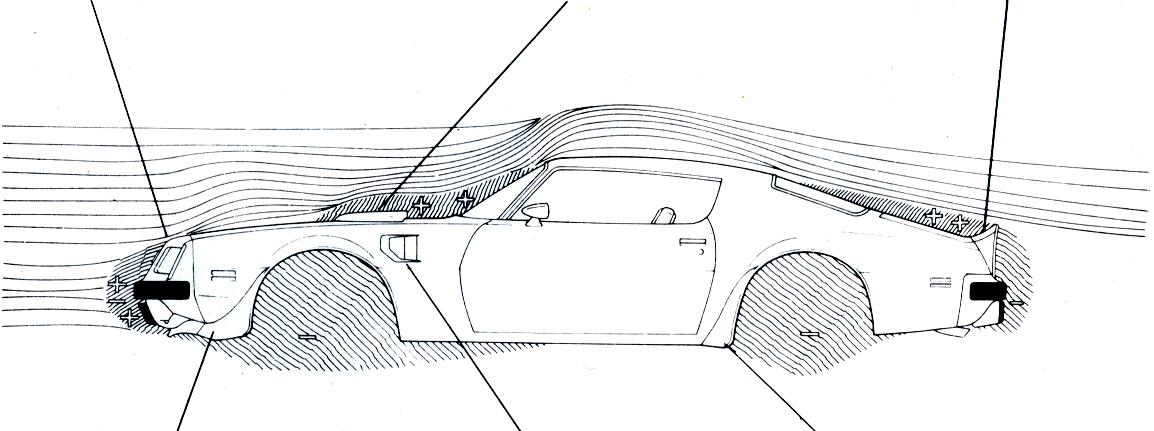 The Trans Am was different. Pontiac's engineers as well as the design team put together a package that managed the air flow. The made the air work for the car. While the assortment of spoilers, spats, and shakers made a stunning visual impact, the fact that they were designed to work a well as they looked is a tribute to those involved. B. | Front Fender Air
Extractors |
|
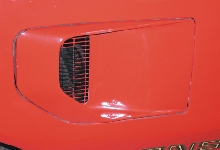 Front fender exhaust vents have been a part of
the automobile for almost as long as there have been fenders on cars. If you care to
journey back to the pre integrated fender era, the hood of many cars of the period had
vents on the sides of the cars to get rid of excess engine heat. The front fender air
extractors on the T/A do remove heat from the engine compartment, but that is just one
of their responsibilities.
Front fender exhaust vents have been a part of
the automobile for almost as long as there have been fenders on cars. If you care to
journey back to the pre integrated fender era, the hood of many cars of the period had
vents on the sides of the cars to get rid of excess engine heat. The front fender air
extractors on the T/A do remove heat from the engine compartment, but that is just one
of their responsibilities.
Pure sports and racing cars of the 50's and 60's used fender vents to reduce the air
pressure beneath the hood, thereby reducing lift. By giving the air that enters the engine
The front fender air extractor, is the vent is located in a depressed area of the
housing, in kind of a backward scoop. This design takes advantage of the "Venturi"
effect, using air flowing accross the air extractor to create a low pressure area,
Later, the Camaro Z28 would employ a similar fender air extractor, but this was done
more to match the visual appeal of the Trans Am's air extractors. C. | Front Spoiler Vairiations
|
While the front fender air extractors were basicly
changeless during the 12-year run of the second generation Trans Am, the spoiler went thru
five variations.
|
1970-1973 - The original front spoiler was an integral part of the aero package
1974-1975 - When it was time for the Trans Am to receive the Federaly mandated
1976 - A new front end with a more integrated appearance debuted in 1976, and
1977-1978 - A new nose piece combining the front bumper and the header
panel into a single piece of urethane meant it was time for yet another front spoiler
vairiation. This new spoiler was actually a combination of the front under pan and
the spoiler. Made in an impact resistant plastic the pan used bolts and tabs extending
from the pan to hold it into place. The spoiler portion extended barely over an inch
1979-1981 - The final version of the Trans Am front spoiler variation was
Which front spoiler had the greatest appeal? This is a tough one to call because they all had the same intent and thier design was ultimately determined by the front end style they were attached to. D. | Rear Spoiler Vairiations
|
While the front spoiler went thru numerous changes
during the twelve year production run, the rear spoiler was limited to two, and these changes
|
 were limited to the end caps. Before we examine the end caps singularly, let's look at
the rear spoiler as a unit. When viewed end on the spoiler appears to be an efficient
devise, carefully breaking up the airflow as it leaves the decklid, lowering drag and
increasing downforce. Yes, that's correct, a rear spoiler at highway speeds (around
70 mph) as the original designers had intended creates about 50 pounds of positive
downforce. While 50-lbs. of downforce may not seem much in light of modern racing cars
creating hundreds of pounds of downforce remember the average passenger car creates
lift as if travels down the freeway.
were limited to the end caps. Before we examine the end caps singularly, let's look at
the rear spoiler as a unit. When viewed end on the spoiler appears to be an efficient
devise, carefully breaking up the airflow as it leaves the decklid, lowering drag and
increasing downforce. Yes, that's correct, a rear spoiler at highway speeds (around
70 mph) as the original designers had intended creates about 50 pounds of positive
downforce. While 50-lbs. of downforce may not seem much in light of modern racing cars
creating hundreds of pounds of downforce remember the average passenger car creates
lift as if travels down the freeway.
Although the downforce generated is wonderful, if
the engineers would have truely had their way the spoiler end caps would have taken on
When 1979 rolled around,
Opinions vary as to which rear spoiler looks the best. The original is tough to beat and did survive for nine years. But the rear spoiler that was used for the final three years was certainly more aggressive, despite being softened, so it to has its own appeal. Like the front spoiler, the rear spoiler is ultimately decided by the year of the car. E. | Wheel Spats |
|
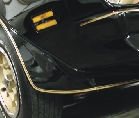
Wheel spats or wheel air deflectors, whichever
name you wish to use, were another often imitated component of the Trans Am's aerodynamic
package. The spats deflected air around the turbulence of the tires, cleaning up a bit of
aero drag for a tradeoff of just a bit of frontal area. In the front, the spats were prone
to bug strikes as well a the occasional stone from other vehicles. At the rear, a "sand
During the era, companies offered "foilers", which mimicked the wheel spats, only turned
around. These were a very stylish way to add mud & stone deflectors to your car, and unlike
The popularity of the Trams Am's wheel spats did not go unnoticed by the other manufacturers. AMC got into the game with the Hornet based AMX. Chevrolet added them to the Camaro Z28 and the Monza Spyder. At Ford, similar wheel spats were added to the 1978 "King Cobra" edition of the Mustang II. All tried to copy the look benchmarked by the Trans Am, but a copy is merely a substitute for the real thing! 2) | Interior Appointments |
A. | Introduction |
When it came to interior selection, the Second Generation Trans Ams were at the forefront styling. A beautiful instrument panel, wonderful appearing seats, a variety of sound systems, and a host of luxury and convenience features abounded. This section will go over many of the interior features available on Trans Ams. B. | Rear Seat Console |
|
|
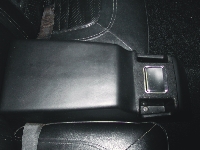
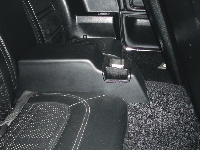
Of all the neat features ever to grace a Trans Am, the rear seat console has to be one
of the best. Ahead of its time, the option had a short lived lifespan, seven production years;
1971-1977. When introduced, the rear seat console gave the rear passengers a center
armrest as well as a place to put the inboard seat belt buckles. In 1973, outboard
retractors eliminated the buckles with adjusters. Now the belt webbing was not long
enough for the new buckles to fit in the console pockets. While the rear seat console no
longer had a functional purpose, the appearance factor was well worth the small cost. In
hindsight we can say this, but the reality at the time must have been different. Usually
GM will eliminate an option when it falls below the 5% penetration level. This means in
1977 there was a likihood of only around 7,800 rear seat consoles being ordered
(accross the entire Firebird line), so the rarity of this item (as a percentage level)
is nearly equivilant to a 1970 Ram Air IV!. |
C. | Formula Steering Wheel |
|
| 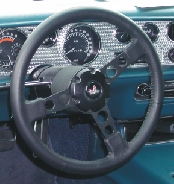 With a name like "Formula Steering Wheel" in a Trans Am, it almost sounds like the cart was
put before the horse. Here was the a steering wheel named after the Trans Am's cousin.
Shouldn't the best steering wheel have been named the "Trans Am" steering wheel?
With a name like "Formula Steering Wheel" in a Trans Am, it almost sounds like the cart was
put before the horse. Here was the a steering wheel named after the Trans Am's cousin.
Shouldn't the best steering wheel have been named the "Trans Am" steering wheel?
Whatever the chosen name, the Formula steering wheel was almost the perfect
appliance to point your Trans Am in the desired direction. The 14-inch diameter was
The wheel was available in colors that matched the interior; unlike the 3rd and 4th
generation wheels that are available in any color you want as long as it's black.
The spokes were available in a black finish, a natural finish, or in the gold finish
The wheel rim section was held to a cast aluminum collar that was finished with
a "crinkle" paint treatment. Allen head bevel screws attached the wheel to the collars
and were coated with a "thread locking" material to keep the threads from backing out.
After all, it would be bad news to require your customers to periodicly tighten the
steering wheel.
From 1970 to 1972, the steering wheels included a stitched wrapping, but beginning
in 1973 the wheel rims were made of a rubberized vinyl with a simulated leather covering,
right down to the fake stitching. On 10th Anniversary models, the wheel was treated to
a real leather covering, complete with genuine stitching! The leather was a medium
gray color to match the horn button and most of the other interior appointments.
The spokes were done in a semi-machined finish with the left and right spokes having
a straight accross pattern, and the vertical spoke having it's grain going up-down
This steering wheel was indeed near perfect. My only complaint with the wheel is that angle of the non-tilt wheel obscures the speedometer with the top of the wheel rim when going straight ahead. Then again I'm a short guy so this might not be a problem for those of you who are not vertically challenged. D. | Bucket Seat Variations |
| The interior of a Trans Am could be equipped from spartan to lavish.
During the 2nd Gen's production run, you could equip your T/A from basic vinyl,
to lavish leather. There were seats called "horse collars" and seats tagged with
the prestigious Recaro nameplate. From Madrid Vinyl to Hobnail Cloth, the Trans
Am always had an appealing interior. The T/A had an edge on the sister Camaro as
the Camaro's best was just about even to the Trans Am's worst. (Whoa did I use
"worst" in the same sentence as "Trans Am"? Sorry, just trying to get a point
accross!).
| I. | 1970 Low Back Bucket Seats |
|
The 1970 Trans Am holds the distinction of having several one year options: The 400
V8 was available in two variations, the Ram Air III, and Ram Air IV, both with
compression ratios over 10.25:1. 1970 was the only year with a 12-bolt rear
axle. Another feature unique to the 1970 models were the low back bucket seats.
| The low back seats in Trans Ams all featured an adjustable head restraint,
II. | 1971-75 - Standard |
|
| 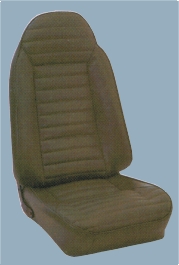 When the 1971 Trans Am was introduced, the bucket seats were as radically different
between the 1970 models as the 1969 varied in body shape. The new seats were a wonderfully
modern high back design with a pleated headrest that was now an integral part of the seat.
This basic seat design would remain relatively unchanged until the end of second generation
production. The new buckets wrapped around the passengers in the seatback portion of the
seats much better than the nearly flat profile of the '70's seats.The seats were
finished in Madrid Vinyl.
When the 1971 Trans Am was introduced, the bucket seats were as radically different
between the 1970 models as the 1969 varied in body shape. The new seats were a wonderfully
modern high back design with a pleated headrest that was now an integral part of the seat.
This basic seat design would remain relatively unchanged until the end of second generation
production. The new buckets wrapped around the passengers in the seatback portion of the
seats much better than the nearly flat profile of the '70's seats.The seats were
finished in Madrid Vinyl.
III. | 1971-72 - Custom |
|
The 1971 Deluxe interior was similar in design to the 1970 seats, with comfortweave (knitted)
vinyl inserts with Madrid vinly bolsters. The seats had a great look with the comfortweave
portion stretching from the center part of the seat and being pleated and seamed at the
bolsters. For 1972, the seat pattern retained the same basic shape and sew style, but the
comfortweave insert was replaced perforated Tetra vinyl insert.
| 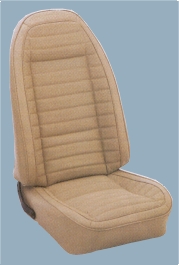
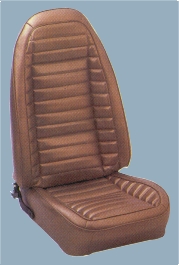
| IV. | 1973-75 - Custom |
|
What a change for 1973. The bucket seats now took on the most expensive looking interior
offered in a Trans Am until the 10th Anniversary model rolled around with genuine leather.
The seats retained the same fabric, Madrid vinyl for the seat bolsters and perforated
Tetra vinyl inserts. These seats screamed sit on me with a the deep bucketing in the
center part of the seat with aggressive "wrap-around" bolsters on the seat cushion and
back, helping to keep you in place when you hustled your Trans Am around the corners.
|
| 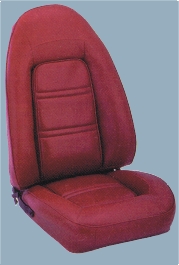
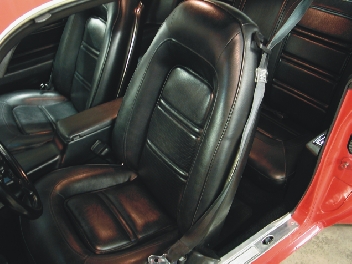
| 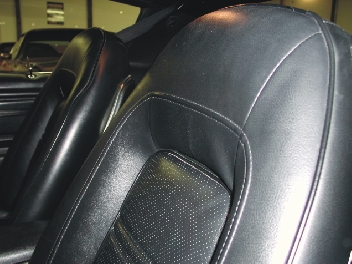
The seats illustrated are from the
National Parts Depot
catalog. 1-800-235-3445.
|
|
| | ||||||||||||||||||||||||||||||||||||||||||||||||||||||||||||||||||||||||||||